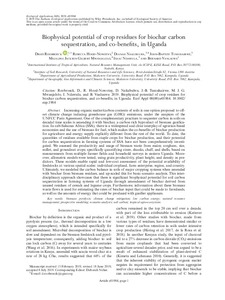| dc.contributor.author | Roobroeck, D. |
| dc.contributor.author | Hood‐Nowotny, R. |
| dc.contributor.author | Nakubulwa, D. |
| dc.contributor.author | Tumuhairwe, J.B. |
| dc.contributor.author | Mwanjalolo, M.J.G. |
| dc.contributor.author | Ndawula, I. |
| dc.contributor.author | Vanlauwe, B. |
| dc.date.accessioned | 2019-12-04T11:39:06Z |
| dc.date.available | 2019-12-04T11:39:06Z |
| dc.date.issued | 2019 |
| dc.identifier.citation | Roobroeck, D., Hood‐Nowotny, R., Nakubulwa, D., Tumuhairwe, J.B., Mwanjalolo, M.J.G., Ndawula, I. & Vanlauwe, B. (2019). Biophysical potential of crop residues for biochar carbon sequestration, and co‐benefits, in Uganda. Ecological Applications, 1-10. |
| dc.identifier.issn | 1051-0761 |
| dc.identifier.uri | https://hdl.handle.net/20.500.12478/6528 |
| dc.description | Open Access Journal; Published online: 27 July 2019 |
| dc.description.abstract | Increasing organic matter/carbon contents of soils is one option proposed to offset climate change inducing greenhouse gas (GHG) emissions, under the auspices of the UNFCC Paris Agreement. One of the complementary practices to sequester carbon in soils on decadal time scales is amending it with biochar, a carbon rich byproduct of biomass gasification. In sub‐Saharan Africa (SSA), there is a widespread and close interplay of agrarian‐based economies and the use of biomass for fuel, which makes the co‐benefits of biochar production for agriculture and energy supply explicitly different from the rest of the world. To date, the quantities of residues available from staple crops for biochar production, and their potential for carbon sequestration in farming systems of SSA have not been comprehensively investigated. We assessed the productivity and usage of biomass waste from maize, sorghum, rice, millet, and groundnut crops; specifically quantifying straw, shanks, chaff, and shells, based on measurements from multiple farmer fields and household surveys in eastern Uganda. Moreover, allometric models were tested, using grain productivity, plant height, and density as predictors. These models enable rapid and low‐cost assessment of the potential availability of feedstocks at various spatial scales: individual cropland, farm enterprise, region, and country. Ultimately, we modeled the carbon balance in soils of major cropping systems when amended with biochar from biomass residues, and up‐scaled this for basic scenario analysis. This interdisciplinary approach showcases that there is significant biophysical potential for soil carbon sequestration in farming systems of Uganda through amendment of biochar derived from unused residues of cereals and legume crops. Furthermore, information about these biomass waste flows is used for estimating the rates of biochar input that could be made to farmlands, as well as the amounts of energy that could be produced with gasifier appliances. |
| dc.description.sponsorship | Austrian Development Agency |
| dc.format.extent | 1-10 |
| dc.language.iso | en |
| dc.rights | CC-BY-4.0 |
| dc.subject | Climate Change Mitigation |
| dc.subject | Natural Resources Management |
| dc.subject | Greenhouse Gases |
| dc.subject | Cropping Systems |
| dc.subject | Subsaharan Africa |
| dc.title | Biophysical potential of crop residues for biochar carbon sequestration, and co-benefits, in Uganda |
| dc.type | Journal Article |
| dc.description.version | Peer Review |
| cg.contributor.crp | Climate Change, Agriculture and Food Security |
| cg.contributor.crp | Maize |
| cg.contributor.crp | Roots, Tubers and Bananas |
| cg.contributor.affiliation | International Institute of Tropical Agriculture |
| cg.contributor.affiliation | University of Natural Resources and Life Sciences, Austria |
| cg.contributor.affiliation | Makerere University |
| cg.coverage.region | Africa |
| cg.coverage.region | East Africa |
| cg.coverage.country | Uganda |
| cg.creator.identifier | Dries Roobroeck: 0000-0003-3176-4444 |
| cg.creator.identifier | bernard vanlauwe: 0000-0001-6016-6027 |
| cg.researchtheme | NATURAL RESOURCE MANAGEMENT |
| cg.isijournal | ISI Journal |
| cg.authorship.types | CGIAR and developing country institute |
| cg.iitasubject | Climate Change |
| cg.iitasubject | Crop Systems |
| cg.iitasubject | Natural Resource Management |
| cg.journal | Ecological Applications |
| cg.howpublished | Formally Published |
| cg.accessibilitystatus | Open Access |
| local.dspaceid | 109829 |
| cg.targetaudience | Scientists |
| cg.identifier.doi | https://dx.doi.org/10.1002/eap.1984 |

